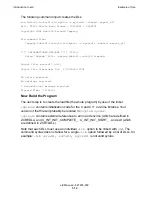
Introduction to eld
eld Manual—527255-009
1-5
The Linker Command Stream
Some DLLs are called public libraries because they are provided as part of the TNS/E
implementation and are found in a special way by the linker and runtime loader. A
public library has the same format as any other DLL, and can have an import library to
represent it.
Some of the public libraries are called implicit libraries because they are used at link
time and run time without explicit mention on the part of the user. There are several
implicit libraries, and there is a bit in a DLL that tells if it is an implicit library. A single
implicit library never has an import library to represent it to the linker. Rather, at link
time, when building a loadfile that is not an implicit library, a single import library
represents the entire set of implicit libraries. That is called the import library that
represents the implicit libraries, and it is always a complete import library.
For detailed information about PIC programs and developing DLLs, see the
DLL
Programmer’s Guide for TNS/E Systems
.
There is also an equivalent manual for TNS/R systems, the
DLL Programmer’s Guide
for TNS/R Systems
.
The Linker Command Stream
The following definitions of terms such as option, parameters and filenames is specific
only to
eld
. In other environments and products, similar concepts might go under
different names, for example OSS calls options “flags”.
The linker obtains tokens
from the command line by using the
argc
and
argv
functions of C. The way this works may be dependent on the C runtime
implementation, but the general idea is that tokens are separated by spaces. On the
PC it may be useful to include a space within a filename, and that can be done by
placing quotation marks around the name. The C runtime gives the name to the linker
without the surrounding quotation marks.
Certain options, such as the
-obey
option, cause the linker to obtain tokens from files,
and the linker mostly treats them the same as if they were on the command line. The
linker’s command line, plus the other tokens it obtains in such ways from files, are
collectively called the linker’s command stream.
Tokens are categorized as options, parameters, or filenames. An option always starts
with a hyphen. A filename or parameter never starts with a hyphen. Each option
requires a certain number of parameters to immediately follow it.
eld
reports an error if
the linker cannot parse the command stream into a sequence of options and/or
filenames, where each option is followed by the required number of parameters.
Names of options and parameters must be spelled exactly as given in this manual.
Except for the options named
-l
and
-L
, options and keyword parameters are not
case sensitive.
Options may be placed into one of three categories:
Summary of Contents for eld
Page 4: ......
Page 8: ...Contents eld Manual 527255 009 iv ...
Page 12: ...What s New in This Manual eld Manual 527255 009 viii Changes to the 527255 005 Manual ...
Page 34: ...Introduction to eld eld Manual 527255 009 1 14 Example of Use ...
Page 54: ...eld Input and Output eld Manual 527255 009 2 20 Using Archives ...
Page 98: ...Other eld Processing eld Manual 527255 009 4 20 Merging Source RTDUs ...
Page 242: ...Output Listings and Error Handling eld Manual 527255 009 6 132 Glossary of Errors ...
















































